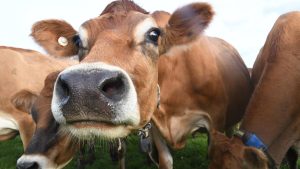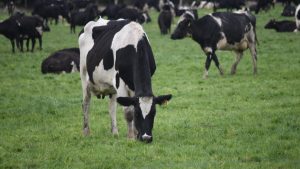
But for third-generation dairy farmer Leigh Shearman, things still haven’t improved.
“Even though the flood was the 28th of February, if anything things have got worse because of the continued wet weather,” she said.
With fences down and cows getting sick from standing in muddy paddocks, Ms Shearman had to make the heartbreaking decision to sell young stock and agist some of her herd 1,000 kilometres away.
“Financially my milk production has halved, so costs have gone up and milk production has come down,” she said.
“I do worry what the northern dairy industry is going to look like by the end of winter.
Canefarmers lose homes and crops
On the coastal flood plain near Woodburn, widespread destruction is clearly on show with fields of once-green sugar cane, now littered with brown stalks.
One-year-old cane has been almost completely destroyed after being submerged in flood water for weeks.
Chairman of the Woodburn cane harvesting co-operative, Geoff Gollan, is still deliberating how harvesters will salvage what’s left.
It’s too wet to get machinery on the ground, and the thick flood mud in the field adds another challenge to starting cane fires, which typically happen just before harvest.
Adding to the woes, so called “orphan rubbish” is littered throughout the fields, dumped indiscriminately through paddocks as the Richmond River consumed the floodplain.
“It’s a major problem,” he said.
The 65-year-old is slowly coming to terms with not just the scale of losses in the paddock, but his community.
“The cane harvesting community in our local area, all have lost their homes, bar three,” he said.
“We’ve got 27 members.”
Down the road at East Coraki, Geoff Pye is facing a long wait for repairs before he can move back into his home.
But he tries to see the humour in finding a neighbour’s in-ground swimming pool in his canefield.
“The thing floated along until it finally filled up with water and just sat down in the cane,” he said.
“It looks like it’s in good nick, hopefully we can return it to its owner.”
‘Tragic’ year for soybean
The season has been one to forget for the soybean industry too.
Ross Larsson operates Mara Global Foods, a food and stock feed manufacturing plant based near Casino.
“When you start to see commerce start to grind to a halt, you know, that effects everyone who owns a takeaway shop through to bigger companies like ours.”
Mr Larsson estimates more than 80 per cent of farmers will not be able to sow a winter crop this year because of the ongoing wet conditions.
“A lot of the guys can’t even farm the country because their tractors completely went underwater; it’s a struggle to get replacement equipment here, planters have been lost.”
He said serious government intervention was needed.
“It’s every shop that you walk into in Casino, it’s every shop you walk into that’s left in Lismore; everybody’s affected, you can see it,” he said.
Macadamia industry bracing for mass losses
The Richmond River flood plain is also a growth corridor for the macadamia industry.
More than 270,000 trees have been planted here over the past five years.
Mel and Ron Caccianiga planted 10,000 trees to help scale up their existing orchard near Lismore.
“We started farming with the design that we are on a flood plain and we’ve put checks and balances in place to work with that,” Mrs Caccianiga said.
Trees are planted on 40-centimetre mounds, in theory to allow flood water to drain off.
“We came out of the first flood OK, full of optimism, and were thinking about 20 per cent loss,” she said.
“But when it rained and rain and the second flood came in, we had water over the block again for another 10 days.”
Mrs Caccianiga is emotional at the thought of losing the young stock she has planted.
“We’ve walked along the planter, we’re made sure it’s been planted in the right soil, we’ve pruned its growth to get the architecture in the tree we wanted.
“We’ve looked at this as a really long-term venture for us.
“It’s not a development, it’s our family’s future.”
It’s not enough to deter the Caccianigas, who are readying to step back in behind the planter and do it all again.
“We won’t plant ’til spring, but we can certainly get the soil in really great shape between now and then, ready for that planting,” she said.

























